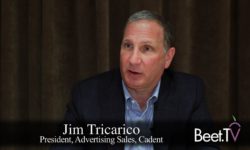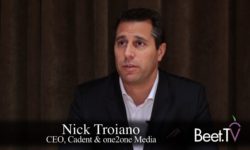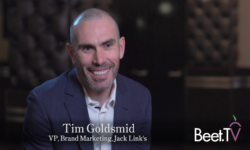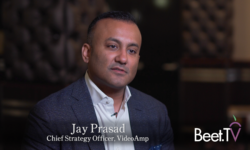Even as the availability of addressable television advertising continues to grow, delivering more precise audience targeting, it will likely always be a complement to traditional mass advertising efforts. In the meantime, it’s bringing TV to brands with targets heretofore too small for spending on the medium and providing valuable targeting insights, according to Lyle Schwartz, Chief Investment Officer at GroupM NA.
In this video interview with Beet.TV, taped last week at the Cadent & one2one Media UpFront event, the media veteran talks about the three buckets of TV ads—broad distribution, indexing by overlaying data and “served”—along with the risks of not doing addressable well.
The “served” bucket “can be digital, but addressable fits into served, which is we’re sending an ad right to the household or person that we want to receive that message,” says Schwartz. “That area over time is growing and the distribution capabilities are growing.”
Many marketers are very targeted, something has limited their use of traditional television advertising. “They can’t afford it because their target may be one or two percent of the United States,” Schwartz says.
Addressable “allows us to serve those ads to that small population and allows our communications options to grow for those type of ads.”
Another benefit to addressable is that it can facilitate lots of testing, according to Schwartz. “By looking at people, you no longer have to go county-to-county or state-to-state. We can do on-off right next door to each other and make sure that the people are very similar.”
Nonetheless, addressable will likely never constitute 100% of an advertiser’s spending “because you still want to feed the top of the bucket. But when you get to the actual sales and last step, last quarter mile, addressable focused in that manner seems to have a very good return,” Schwartz adds.
He’s still optimistic about the growing penetration of addressable TV, as more MVPD’s warm to it, despite current constraints on the available volume of inventory.
“So I just think that this area is going to continue to grow, and as the economies and capabilities grow and technology is dispersed in the United States, it will have a tremendous upside potential.”
Schwartz cautions that “potential” can be “a very dangerous word.” In the context of addressable TV, one challenge is learning how to use it “in the right manner and make sure that it’s an appropriate use of the vehicle.”
This is because with addressability, “you’re either going to hit the person or not. And if the targeting is off, the person’s not going to get any impressions. That’s why I only think that addressable is going to be a component of the communications platforms used, not the sole.”
This video was produced at the Cadent & one2one Media UpFront 2018 industry summit. You can find more videos from the series here. The sponsors for this series are Cadent and one2one Media.




































